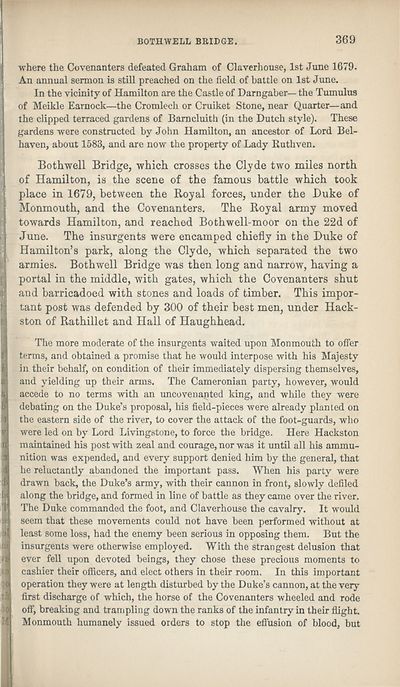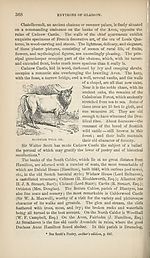Download files
Complete book:
Individual page:
Thumbnail gallery: Grid view | List view

BOTH WELL BRIDGE.
369
where the Covenanters defeated Graham of Claverhouse, 1st June 1679.
An annual sermon is still preached on the field of battle on 1st June.
In the vicinity of Hamilton are the Castle of Darngaber— the Tumulus
of Meikle Earnock—the Cromlech or Cruiket Stone, near Quarter—and
the clipped terraced gardens of Barncluith (in the Dutch style). These
gardens were constructed by John Hamilton, an ancestor of Lord Bel-
haven, about 1583, and are now the property of Lady Ruthven.
Bothwell Bridge, which crosses the Clyde two miles north
of Hamilton, is the scene of the famous battle which took
place in 1679, between the Royal forces, under the Duke of
Monmouth, and the Covenanters. The Royal army moved
towards Hamilton, and reached Bothwell-moor on the 22d of
June. The insurgents were encamped chiefly in the Duke of
Hamilton’s park, along the Clyde, which separated the two
armies. Bothwell Bridge was then long and narrow, having a
portal in the middle, with gates, which the Covenanters shut
and barricadoed with stones and loads of timber. This impor¬
tant post was defended by 300 of their best men, under Hack-
ston of Rathillet and Hall of Haughhead.
The more moderate of the insurgents waited upon Monmouth to offer
terms, and obtained a promise that he would interpose with his Majesty
in their behalf, on condition of their immediately dispersing themselves,
and yielding up their arms. The Cameronian party, however, would
accede to no terms with an uncovenanted king, and while they were
debating on the Duke’s proposal, his field-pieces were already planted on
the eastern side of the river, to cover the attack of the foot-guards, who
were led on by Lord Livingstone, to force the bridge. Here Hackston
maintained his post with zeal and courage, nor was it until all his ammu¬
nition was expended, and every support denied him by the general, that
he reluctantly abandoned the important pass. When his party were
drawn back, the Duke’s army, with their cannon in front, slowly defiled
along the bridge, and formed in line of battle as they came over the river.
The Duke commanded the foot, and Claverhouse the cavalry. It would
seem that these movements could not have been performed without at
least some loss, had the enemy been serious in opposing them. But the
insurgents were otherwise employed. With the strangest delusion that
ever fell upon devoted beings, they chose these precious moments to
cashier their officers, and elect others in their room. In this important
operation they were at length disturbed by the Duke’s cannon, at the very
first discharge of which, the horse of the Covenanters wheeled and rode
off, breaking and trampling down the ranks of the infantry in their flight.
Monmouth humanely issued orders to stop the effusion of blood, but
369
where the Covenanters defeated Graham of Claverhouse, 1st June 1679.
An annual sermon is still preached on the field of battle on 1st June.
In the vicinity of Hamilton are the Castle of Darngaber— the Tumulus
of Meikle Earnock—the Cromlech or Cruiket Stone, near Quarter—and
the clipped terraced gardens of Barncluith (in the Dutch style). These
gardens were constructed by John Hamilton, an ancestor of Lord Bel-
haven, about 1583, and are now the property of Lady Ruthven.
Bothwell Bridge, which crosses the Clyde two miles north
of Hamilton, is the scene of the famous battle which took
place in 1679, between the Royal forces, under the Duke of
Monmouth, and the Covenanters. The Royal army moved
towards Hamilton, and reached Bothwell-moor on the 22d of
June. The insurgents were encamped chiefly in the Duke of
Hamilton’s park, along the Clyde, which separated the two
armies. Bothwell Bridge was then long and narrow, having a
portal in the middle, with gates, which the Covenanters shut
and barricadoed with stones and loads of timber. This impor¬
tant post was defended by 300 of their best men, under Hack-
ston of Rathillet and Hall of Haughhead.
The more moderate of the insurgents waited upon Monmouth to offer
terms, and obtained a promise that he would interpose with his Majesty
in their behalf, on condition of their immediately dispersing themselves,
and yielding up their arms. The Cameronian party, however, would
accede to no terms with an uncovenanted king, and while they were
debating on the Duke’s proposal, his field-pieces were already planted on
the eastern side of the river, to cover the attack of the foot-guards, who
were led on by Lord Livingstone, to force the bridge. Here Hackston
maintained his post with zeal and courage, nor was it until all his ammu¬
nition was expended, and every support denied him by the general, that
he reluctantly abandoned the important pass. When his party were
drawn back, the Duke’s army, with their cannon in front, slowly defiled
along the bridge, and formed in line of battle as they came over the river.
The Duke commanded the foot, and Claverhouse the cavalry. It would
seem that these movements could not have been performed without at
least some loss, had the enemy been serious in opposing them. But the
insurgents were otherwise employed. With the strangest delusion that
ever fell upon devoted beings, they chose these precious moments to
cashier their officers, and elect others in their room. In this important
operation they were at length disturbed by the Duke’s cannon, at the very
first discharge of which, the horse of the Covenanters wheeled and rode
off, breaking and trampling down the ranks of the infantry in their flight.
Monmouth humanely issued orders to stop the effusion of blood, but
Set display mode to:
![]() Universal Viewer |
Universal Viewer | ![]() Mirador |
Large image | Transcription
Mirador |
Large image | Transcription
| Antiquarian books of Scotland > Scotland/Scots > Black's picturesque tourist of Scotland > (481) |
|---|
| Permanent URL | https://digital.nls.uk/130033962 |
|---|
| Description | Thousands of printed books from the Antiquarian Books of Scotland collection which dates from 1641 to the 1980s. The collection consists of 14,800 books which were published in Scotland or have a Scottish connection, e.g. through the author, printer or owner. Subjects covered include sport, education, diseases, adventure, occupations, Jacobites, politics and religion. Among the 29 languages represented are English, Gaelic, Italian, French, Russian and Swedish. |
|---|

